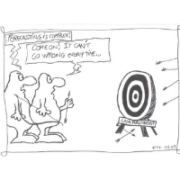Data analysis – pros and cons
| 18-04-2018 | Lionel Pavey |

With the advent of computing and ever more powerful processing capabilities, we are living in a time where there is more and more data available within a company. Advocates of data mining speak of the advantages that can be obtained by analysing all the data and discovering trends within the data. But there is also the risk that we end up being swamped by the data overload – so much data, so little time. If we want to analyse all our data, what is it that we truly want to find? How can we interpret all the data and arrive at beneficial conclusions?
Treasurers and cash managers are long time users of data analysis – it is used to go from a macro level to a micro level for individual transactions. When designing a cash flow forecast it is essential to take the micro approach. There will always be peak days for outflows – wages are paid, normally, on 1 specific day of the month; on the last working day of the month there is large expenditure relating to taxes and social premiums. Additionally, if the company works with monthly subscriptions, there will be peak days for inflows as all the renewals take place. These “exceptional” items need to be input as hard data on the relevant working days to assist in presenting an accurate forecast.
Another application of data analysis is to interrogate the actual Days Sales and Days Purchasing Outstanding – DSOs and DPOs – that make up the cash conversion cycle. A lot of unnecessary working capital can be tied up in this process. Understanding the transactional characteristics of individual debtors and creditors can be very beneficial to freeing up working capital. Furthermore, it allows the company to review their relationships – is it worth maintaining certain contacts if they do not meet the agreed terms and conditions on their trade transactions.
It is also possible to conclude that certain clients could benefit from a more advantageous pricing policy. Rewarding those that comply leads to better relationships and the improvements in cash flow can help reduce external borrowing requirements.
When attempting to analyse data, it is imperative to first understand what you are looking for. Obvious metrics could be month on month sales or purchases, seasonal effects on turnover, new products, promotional offers etc. The act of analysing data, together with the awareness within the company that the data is being analysed, can lead to anomalies caused by people’s actions. Data input could be subject to a form of “window dressing” – entries are made before the end of the month and then corrected in the following month.
It is possible to conclude that there is a trend in the data – some people even look for these – that could lead to a false sense of conclusion. There is also the danger that 2 different streams of data are linked to each other because they show the same trends. When analysing data is it necessary to be open minded about the expected outcome. If people start analysing with a preconceived idea of what the outcome should be, human nature can intervene and the data is interpreted in a way that justifies the preconceived idea.
Data analysis is a technical discipline that can overlook the fundamentals. Before the CDO crisis of 2008, most banks agreed with the interpretation of the underlying data within the systems, without challenging the reality of the scenarios being presented. Even after the crisis started, the banks were unable to foresee the severe impact that it would have on the whole financial market. I have a curious leaning to analysing long term interest rates – I have collated data on Interest Rate Swaps since the inception of the Euro. Whilst I am able to spot long term trends, I have failed in ever calling the top or the bottom of the market.
When analysing data, it is imperative that the basic fundamentals of a company and its products is never forgotten, If sales are down, a more fundamental approach needs to be undertaken. Are our competitors cheaper, are their products better, is the economy in a downturn, are our products obsolete?
Analysis should always be undertaken, but the results must always be weighed up against the reality of the marketplace. It is too easy to draw conclusions – it gives the illusion that the analysis is good.
A lot of good things can come from data analysis, but it must not exclusively determine the actions that a company takes in its quest for growth and survival.

Cash Management and Treasury Specialist









